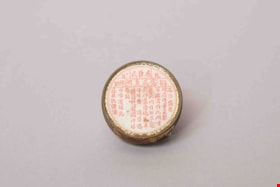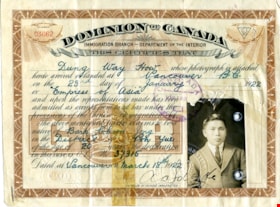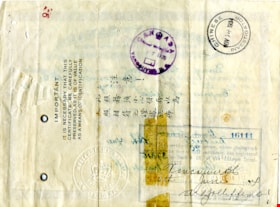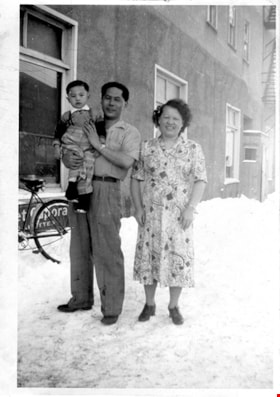Narrow Results By
Subject
- Agriculture 1
- Agriculture - Farms 2
- Buildings - Commercial - Grocery Stores 1
- Buildings - Commercial - Restaurants 1
- Buildings - Schools 1
- Documentary Artifacts - Certificates 1
- Education 2
- First Nations reserves - British Columbia 1
- Migration 2
- Occupations - Grocers 1
- Occupations - Teachers 1
- Organizations 1
bottle
https://search.heritageburnaby.ca/link/museumartifact23979
- Repository
- Burnaby Village Museum
- Accession Code
- HV975.5.402
- Description
- Medicinal wine bottle; transparent green glass, sealed lid wrapped in metallic foil. Around the upper portion of neck an off-white label with light teal Chinese characters. On the main body of the bottle is an orange rectangular label with printed Chinese characters. Second from right in photograph.
- Object History
- This item originates from the Chinese Herbalist Store "Way Sang Yuen Wat Kee & Co.", Victoria B.C.
- Classification
- Chemical T&E
- Marks/Labels
- Label contains characters that are literally translated to: a brand name; "nourish"; "hygiene"; "medicine"; "wine"; and "tincture" (medical alcohol/wine). When adjusted for English comprehension, product is "Health tincture". The tincture includes a mixture of Chinese medicinal herbs with the addition of caterpillar fungus and turtle shell to replenish energy. It has the function of replenishing qi and invigorating qi, replenishing blood, nourshing the kidney,increasing male libido, treating the lack of appetite, refreshing the mind, getting rid of wind in the body, and improving circulation. Circular sticker translates to: "The sale of all secret formulae non-pharmaceutical medicinal preparations in Canada is regulated by The proprietary or patent Medicine Act. This law legalizes the sale of such remedies only upon condition that the quantities of the potent drugs used in their manufacture are within the limitations set by an Advisory Board, and that these quantities are printed on the labels and wrappers used in connection with the medicine and, further, that no false, misleading or exaggerated claims or representations of a cure for any disease are made on the labels and wrappers, or in any other manner respecting this article."
- Measurements
- 30 cm height x 9cm width
- Maker
- ZiBao Tang
- Country Made
- China
- Province Made
- Guangdong
- Site/City Made
- Guangzhou Xiguan
Images
bottle
https://search.heritageburnaby.ca/link/museumartifact23994
- Repository
- Burnaby Village Museum
- Accession Code
- HV975.5.417
- Description
- Medicinal wine bottle; transparent green glass, sealed lid wrapped in metallic foil. Around the upper portion of neck an off-white label with light teal Chinese characters. On the main body of the bottle is an orange rectangular label with printed Chinese characters. Third from right in photograph.
- Object History
- This item originates from the Chinese Herbalist Store "Way Sang Yuen Wat Kee & Co.", Victoria B.C.
- Classification
- Chemical T&E
- Marks/Labels
- Label contains characters that are literally translated to: a brand name; "nourish"; "hygiene"; "medicine"; "wine"; and "tincture" (medical alcohol/wine). When adjusted for English comprehension, product is "Health tincture". The tincture includes a mixture of Chinese medicinal herbs with the addition of caterpillar fungus and turtle shell to replenish energy. It has the function of replenishing qi and invigorating qi, replenishing blood, nourshing the kidney,increasing male libido, treating the lack of appetite, refreshing the mind, getting rid of wind in the body, and improving circulation. The sale of all secret formulae non-pharmaceutical medicinal preparations in Canada is regulated by The proprietary or patent Medicine Act. This law legalizes the sale of such remedies only upon condition that the quantities of the potent drugs used in their manufacture are within the limitations set by an Advisory Board, and that these quantities are printed on the labels and wrappers used in connection with the medicine and, further, that no false, misleading or exaggerated claims or representations of a cure for any disease are made on the labels and wrappers, or in any other manner respecting this article.
- Measurements
- 32 cm height x 9cm width
- Maker
- ZiBao Tang
- Country Made
- China
- Province Made
- Guangdong
- Site/City Made
- Guangzhou Xiguan
Images
bottle
https://search.heritageburnaby.ca/link/museumartifact23995
- Repository
- Burnaby Village Museum
- Accession Code
- HV975.5.418
- Description
- Medicinal wine bottle; transparent green glass, sealed lid wrapped in metallic foil. Around the upper portion of neck an off-white label with light teal Chinese characters. On the main body of the bottle is an orange rectangular label with printed Chinese characters. Far left in photograph.
- Object History
- This item originates from the Chinese Herbalist Store "Way Sang Yuen Wat Kee & Co.", Victoria B.C.
- Classification
- Chemical T&E
- Marks/Labels
- Label contains characters that are literally translated to: a brand name; "nourish"; "hygiene"; "medicine"; "wine"; and "tincture" (medical alcohol/wine). When adjusted for English comprehension, product is "Health tincture". The tincture includes a mixture of Chinese medicinal herbs with the addition of caterpillar fungus and turtle shell to replenish energy. It has the function of replenishing qi and invigorating qi, replenishing blood, nourshing the kidney,increasing male libido, treating the lack of appetite, refreshing the mind, getting rid of wind in the body, and improving circulation. The sale of all secret formulae non-pharmaceutical medicinal preparations in Canada is regulated by The proprietary or patent Medicine Act. This law legalizes the sale of such remedies only upon condition that the quantities of the potent drugs used in their manufacture are within the limitations set by an Advisory Board, and that these quantities are printed on the labels and wrappers used in connection with the medicine and, further, that no false, misleading or exaggerated claims or representations of a cure for any disease are made on the labels and wrappers, or in any other manner respecting this article.
- Measurements
- 32 cm height x 9cm width
- Maker
- ZiBao Tang
- Country Made
- China
- Province Made
- Guangdong
- Site/City Made
- Guangzhou Xiguan
Images
box
https://search.heritageburnaby.ca/link/museumartifact24057
- Repository
- Burnaby Village Museum
- Accession Code
- HV975.5.549
- Description
- Box, green outside, pink inside; with lid, blue mottled design [part of the lid has become detached, but it is not numbered]
- Object History
- This item originates from the Chinese Herbalist Store "Way Sang Yuen Wat Kee & Co.", Victoria B.C.
- Classification
- Container
- Marks/Labels
- White label with red lettering. English translation adjusted to Guangdong, Citrus reticulata Blanco. Guangdong (a province), is Huazhou (a city), Deshengtang (name of a shop), selected, correct or positive, typical, treasure, mountain, orange, red; medicine. This pill is made of many unidentified components. "White turbidity," refers to whitish and cloudy urine. "White turbidity" is a symptom of tiredness, deficiency in kidney qi, and alcohol abuse leading to spleen and stomach disorders. The pill is used to improved the kidneys and nourish the blood, as well as to treat back pain, weakness in the knees, the frequent need to urindate, rheumatism, bone pain, and neurasthenia.
- Measurements
- 25 cm in height x 3 cm in width
- Country Made
- China
- Province Made
- Guangdong
- Site/City Made
- Huazhou
Images
Rooted : Chinese Canadian stories in Burnaby
https://search.heritageburnaby.ca/link/museumlibrary7646
- Repository
- Burnaby Village Museum
- Publication Date
- 2023
- Call Number
- 971.133 ROO
),
Guangdong, China,
1970s. Many of
Burnaby’s Chinese
Canadian farm families
originated from this
county. BV019.10.5. COURTESY
OF THE HONG FAMILY.
泗门村位于中国广东
省的中山县,
1970年
代。
许多定居本拿比的
华裔务农家族都来自
这个县区。
BV019.10.5。
洪氏家族提供。
�7
引言
A Message from the Mayor, Mike Hurley
《扎根:
本拿比的华裔故事》一书讲述华裔
加拿大居民在本拿比市发展过程中的经验与
贡献,
同时也代
- Repository
- Burnaby Village Museum
- Collection
- Digital Reference Collection
- Material Type
- Digital Resource
- ISBN
- 978-0-9689849-2-5
- Call Number
- 971.133 ROO
- Contributor
- Fong, Denise
- Lemke, Jane
- Codd, Lisa
- Place of Publication
- Burnaby
- Publisher
- City of Burnaby
- Publication Date
- 2023
- Printer
- Metropolitan Fine Printers
- Physical Description
- 203 p. : ill. ; 30.5 cm
- Library Subject (LOC)
- Chinese Canadians--British Columbia--Burnaby--History
- Race discrimination -- Canada
- Subjects
- Persons - Chinese Canadians
- Agriculture
- Agriculture - Farms
- Persons - Families
- Rights
- Rights - Human Rights
- Social Issues
- Social Issues - Racism
- Notes
- There are two versions of the book: English and Simplified Chinese (left, below) and the other in English and Traditional Chinese (right, below).
- From the late 1800s to the present day, Chinese Canadians have made Burnaby into a more vibrant and livable city. Rooted: Chinese Canadian Stories in Burnaby brings together a collection of diverse stories and photographs from the community, celebrating the legacy and contributions of Burnaby’s Chinese Canadian community spanning over a century. This coffee-table book features oral histories and interviews with descendants of multigenerational family farms, green grocers, corner stores, restaurants, and places of worship. Also included are archival research and community perspectives on anti-Asian racism, community activism, courage, and resilience.
- The publication has been timed to coincide with the 100th anniversary of the introduction of the Chinese Exclusion Act by the Government of Canada in 1923. This federal legislation followed decades of discriminatory legislation by Canada’s federal, provincial and municipal governments that targeted Chinese Canadians by limiting opportunities to live, work and raise families in Canada. The Chinese Exclusion Act banned almost all migration from China and remained in place until 1947. Publishing this book in 2023 is an effort by the City of Burnaby to recognize the impact of discriminatory legislation on Chinese Canadians in our community, including discriminatory bylaws and practices implemented by Burnaby’s early municipal government.
- Edited by Denise Fong (Lead Researcher), Jane Lemke (Burnaby Village Museum Curator) and Lisa Codd (City of Burnaby Heritage Planner).
Images
Digital Books
Chinese Canadian history in Burnaby resource guide
https://search.heritageburnaby.ca/link/museumlibrary7608
- Repository
- Burnaby Village Museum
- Publication Date
- [2022]
- Call Number
- 971.1 CHI
from Sun Woy/ Xinhui county,
Guangdong. He purchased a grocery store business on Kingsway
at Griffiths Ave in Burnaby in 1962 and named it C&L Grocery. The
family grocery store sold groceries and canned goods and was in
business for approximately 15 years.
BV021.18.3, COURTESY OF THE LEE FAMILY
- Repository
- Burnaby Village Museum
- Collection
- Digital Reference Collection
- Material Type
- Digital Resource
- Accession Code
- BV022.8.1
- Call Number
- 971.1 CHI
- Contributor
- City of Burnaby
- Place of Publication
- Burnaby, BC
- Publisher
- City of Burnaby
- Publication Date
- [2022]
- Physical Description
- 36 p. ; ill. (some col.), maps, ports
- Library Subject (LOC)
- Burnaby (B.C.)--History
- Burnaby (B.C.)--Social Life and Customs
- Chinese Canadians--British Columbia--Burnaby--History
- Chinese--British Columbia--History
- Pharmacy--Canada
- Pharmacy--United States
- Pharmaceutical museums
- Directories
- Object History
- Chinese Canadians have contributed to Burnaby’s growth for over a century. The long and intertwining histories between Chinese Canadians, Indigenous people and other communities have shaped the founding of Burnaby and British Columbia. This resource guide was created because their life experiences and important contributions to Burnaby’s development are not widely known.
Images
Digital Books
Larry Lee family fonds
https://search.heritageburnaby.ca/link/museumdescription19071
- Repository
- Burnaby Village Museum
- Collection/Fonds
- Larry Lee family fonds
- Description Level
- Fonds
- Physical Description
- 14 photographs + 3 p. of texutal records
- Scope and Content
- Fonds consists of photographs of the Dragon Inn restaurant in Burnaby, Lee family photographs and certificates awarded to Larry Lee.
- Repository
- Burnaby Village Museum
- Collection/Fonds
- Larry Lee family fonds
- Description Level
- Fonds
- Physical Description
- 14 photographs + 3 p. of texutal records
- Scope and Content
- Fonds consists of photographs of the Dragon Inn restaurant in Burnaby, Lee family photographs and certificates awarded to Larry Lee.
- History
- Larry Lee was born in Dawan village, Kaiping, Guangdong, China in 1932. As a child, he attended school at the Dawan village primary school, and later the Kaiqiao middle school. During the Second World War, the Japanese army took over parts of Guangdong. Due the circumstances at the time, Larry quit school and returned to the village. He arrived in Vancouver, Canada in 1949 at the age of 16 by plane, which stopped in Hong Kong, Shanghai, Tokyo, Guam, Hawaii, and Seattle before reaching its final destination in Vancouver. With no English language skills upon arrival, he attended Sir William Dawson School in Vancouver and was placed in grade five surrounded by mostly white children. His father Lee Soon was already in Canada many years before Larry arrived, and paid the Chinese head tax to come to Canada. Lee Soon operated the Puss and Boots coffee shop located on Robson Street and Richards Street and was one of the restaurant’s cooks. As a teenager, Larry's first job in Canada was working at the Puss and Boots as a restaurant helper. Later on, he took a full time job working at the Bamboo Terrace restaurant in Chinatown, and was eventually promoted to become a buyer for the restaurant. He met his wife Git Nung Lee "Kathy" who came from Xinhui county, Guangdong, in the 1950s while she was working for the produce wholesaler Tom Yee, which was located on Keefer Street between Gore and Main Street in Chinatown. Kathy's grandfather originally operated a fireworks factory in Vancouver. After an accident which involved an explosion at the factory, her father closed down the company and opened the Fong Lee BBQ Meatshop in Chinatown. Kathy and Larry married in 1958. Larry and Kathy lived in Burnaby where they raised their eight children. In the late 1950s, Larry and Kathy opened the first Dragon Inn restaurant on Slocan Road and Kingsway area along with seven other partners who mostly originated from Larry's hometown in Kaiping. The business partners eventually parted ways, and a second Dragon Inn restaurant opened in the Willingdon and Kingsway area. The third restaurant, named the Park Inn, opened up at Welwyn Street and Kingsway. A fourth restaurant, also named the Dragon Inn, was established on Willingdon and Hastings Street. Finally, a fifth Dragon Inn restaurant was opened in New Westminster on Columbia Street. Larry retained ownership of the Willingdon and Kingsway location, and sold the remaining businesses. Over the years, he purchased property around the block of his restaurant, and sold the land to developers who constructed the Crystal Mall. Larry and Kathy operated the Grand Buffet restaurant on Kingsway in the late 1990s for five years before they sold the business and retired. The Dragon Inn was known for its exterior neon sign which was removed in 1997. Larry Lee was a member of the International Association of Lions Club and a duly elected member of the Lions Club of Vancouver Champlain Heights. Larry Lee died in 2019 and his wife Kathy died in 2022.
- Responsibility
- Lee, Larry
- Accession Code
- BV017.37
- BV022.19
- Media Type
- Photograph
- Textual Record
- Notes
- Title based on contents of fonds
Interview with Josephine Chow by Denise Fong February 7, 2020
https://search.heritageburnaby.ca/link/museumdescription12337
- Repository
- Burnaby Village Museum
- Date
- [1900-2020] (interview content), interviewed Feb. 7, 2020
- Collection/Fonds
- Burnaby Village Museum fonds
- Description Level
- Item
- Physical Description
- 1 sound recording (mp3) (00:43:19 min.)
- Scope and Content
- Recording consists of an interview with Josephine Chow (nee Hong) conducted by BVM researcher Denise Fong at the Burnaby Village Museum. Josephine describes her family history and recollects her childhood experiences in 1950s and 60s while growing with her family on their "Hop On" farm in Burnaby. …
- Repository
- Burnaby Village Museum
- Collection/Fonds
- Burnaby Village Museum fonds
- Series
- Museum Oral Histories series
- Subseries
- Chinese Canadians in Burnaby subseries
- Description Level
- Item
- Physical Description
- 1 sound recording (mp3) (00:43:19 min.)
- Material Details
- Interviewer: Denise Fong Interviewee: Josephine Chow Location of Interview: Burnaby Village Museum Interview Date: February 7, 2020 Total Number of Tracks: 1 Total Length of all Tracks: 00:43:19
- Scope and Content
- Recording consists of an interview with Josephine Chow (nee Hong) conducted by BVM researcher Denise Fong at the Burnaby Village Museum. Josephine describes her family history and recollects her childhood experiences in 1950s and 60s while growing with her family on their "Hop On" farm in Burnaby. The farm is situated in the Big Bend area along Marine Drive and is still in operation today. 0:00-08:45 Josephine Chow provides some historical background on the history of “Hop On Farm” and her family in British Columbia. She tells of how her grandfather Gay Tim Hong and three partners pooled money together to purchase twelve acres on Marine Drive in 1951. Prior to this, most of them farmed on the ʷməθkʷəy̓əm (Musqueam) First Nation Reserve for 20-30 years. It all began when her great grandfather Sui Wing Hong, first came to Canada from China and slowly brought over her grandfather, father and other members of the family. Her grandfather, Gay Tim Hong went back and forth between Canada and China at least four times since he and her grandmother had four children including her father, who was born in 1931. Her father came to Canada at 10 years of age to live with his father. Josephine’s great grandfather came to Vancouver from Zhongshan county in Canton Province (also known as Guangdong). 8:46- 14:20 Josephine provides the names of her siblings from the eldest to the youngest; Pauline, Josephine (herself), Catherine, Noreen, Gary, Darlene and Marlene. She describes what life was like on the farm with her parents working from sunrise to sunset. The family farmed vegetable produce taking orders from local stores in the lower mainland. Often the children helped their parents with the orders starting at eight or nine years of age. Other workers on the farm travelled by bus from Vancouver’s Chinatown. She also tells of how her father was an animal lover and raised chickens, pigeons, geese, koy, goldfish and dogs. 14: 21 – 16:56 Josephine describes what Burnaby was like during the time that she grew up in the late 1950s. She explains that Burnaby was very quiet with nothing being open on Sundays. On the farm, she and her siblings would entertain themselves by playing games like soccer, baseball and kick ball or also by catching frogs, snails, caterpillars and ladybugs. There were neighbours living on Marine Drive and almost every house had someone who we went to the same elementary school. The neighbourhood children would often come to play with them on their farm. 16:56- 26:47 Josephine describes how when they were young there were farms all around them and how on Sunday drives with her father, they would go to feed horses or look at the cows. Josephine shares that her elder sister Pauline was the only one born in China and how when she first arrived that she lived on the ʷməθkʷəy̓əm (Musqueam) First Nations Reserve with their parents before they moved to Burnaby. Josephine recollects that most of her friends were farmer’s kids from the neighbourhood but while in school, she had more Caucasian friends. Josephine and her siblings attended Glenwood Elementary on Marine Drive and later Junior Secondary at McPherson Park (grades 8-10) and Burnaby South Senior Secondary (grades 11-12. ). She shares some of her experiences while attending school. She said that there were about a dozen Asians in school with her, mostly from farming families in the “Flats”. 26:48- 30:45 Josephine describes what life was like for her and her siblings after school. They often helped on the farm when they got home, usually taking care of orders for green onions. Her mother made dinner and did all of the cooking for family and workers on the farm as well as working in the fields. Her father did all of the grocery shopping in Vancouver’s Chinatown two or three times per week where he purchased meat and fish. She says that her grandfather, often travelled by bus every Saturday or Sunday to meet up with friends in Chinatown. Extracurricular activities for her and her siblings included volley ball and soccer as long as it didn’t interfere with their work schedule on the farm. 30:46- 37:03 Josephine describes what occurred while living at home, the food they ate, shopping and attending Chinese school. Her mother cooked only Chinese food, she didn’t know how to cook “Western food”. For school lunches, the kids made their own sandwiches. She tells of a Chinese language school arranged by Mrs. Joe [sic] who lived on Gilley Road and was Canadian born Chinese. Mrs. Joe [sic] also arranged an English class for farmer’s wives on Tuesday nights in which her mother attended. Josephine recollects learning Mandarin from Mrs. Joe [sic] a few days a week after her regular school. Chinese school took place at Riverway School on Meadow Avenue in Burnaby. Mrs. Joe also taught them a lot about Chinese culture including Kung Fu, Chinese Dance and Chinese brush painting. 37:04- 39:39 Josephine describes Medical Care for her and her family in the 1950s and 1960s. She tells of a female Chinese doctor in Vancouver, Dr. Madeline Chung. Dr. Chung was responsible for delivering a lot of Chinese babies including Josephine. The family also visited herbalists in Vancouver Chinatown. They would often buy herbs for colds etc. Josephine also tells of how her parents stayed in touch with family in China by writing letters. Her mother’s family, including her parents and siblings were still in China while most of her father’s family were here in Canada. 39:40- 43:19 – In closing, Josephine shares how life is much busier now and of how she misses the quietness of her days growing up. She briefly describes her life on the family farm now and how different it is from when her parents worked the farm. She explains how farming methods have changed and how they don’t have to work as hard as her parents did.
- History
- Interviewee biography: Josephine Chow (nee Hong) is the second eldest child of Chan Kow Hong and Sui Ha Hong. In 1925, Josephine's grandfather, Gay Tim Hong immigrated to Canada from Zhongshan county in Canton Province (also known as Guangdong). In 1952, her father, Chan Kow Hong joined his father, Gay Tim Hong and by 1953, he established "Hop On Farms" in the Big Bend area of Burnaby near Marine Drive. Josephine grew up on the farm with her parents and six siblings; Pauline, Catherine, Norine, Gary, Darlene and Marlene. In 1969, Josephine's elder sister Pauline and her husband Jack Chan took over the family farm and in 1972 their father and grandfather moved to Kamloops to open a restaurant. As an adult, Josephine worked in several different areas including owning and running her own Aesthetics business. Josephine eventually retired and returned to the farm to assist her siblings. The farm is still in operation. Interviewer biography: Denise Fong is a historical researcher at Burnaby Village Museum. She has degrees in Anthropology (BA) and Archaeology (MA), and is completing her doctoral degree at UBC in Interdisciplinary Studies. Her primary research interests are in Chinese Canadian history and critical heritage studies. She is the co-curator of BVM’s “Across the Pacific” exhibition, and the Museum of Vancouver’s “A Seat at the Table – Chinese Immigration and British Columbia”.
- Creator
- Burnaby Village Museum
- Subjects
- Persons - Chinese Canadians
- Agriculture - Farms
- Education
- Buildings - Schools
- First Nations reserves - British Columbia
- Names
- Chow, Josephine
- Glenwood Elementary School
- McPherson Park Junior Secondary School
- ʷməθkʷəy̓əm (Musqueam)
- Responsibility
- Fong, Denise
- Geographic Access
- Byrne Road
- Accession Code
- BV020.6.1
- Access Restriction
- No restrictions
- Reproduction Restriction
- No known restrictions
- Date
- [1900-2020] (interview content), interviewed Feb. 7, 2020
- Media Type
- Sound Recording
- Historic Neighbourhood
- Fraser Arm (Historic Neighbourhood)
- Planning Study Area
- Big Bend Area
- Related Material
- See also BV017.36*
- Scan Resolution
- 600
- Scan Date
- 12/3/2017
- Scale
- 100
- Notes
- Title based on contents of interview
- Photograph info: Gary Hong and Chan Kow Hong harvesting celery at Hop-On Farms [1969]. BV017.36.4
Images
Audio Tracks
Interview with Josephine Chow by Denise Fong February 7, 2020, [1900-2020] (interview content), interviewed Feb. 7, 2020
Interview with Josephine Chow by Denise Fong February 7, 2020, [1900-2020] (interview content), interviewed Feb. 7, 2020
https://search.heritageburnaby.ca/media/hpo/_Data/_BVM_Sound_Recordings/Oral_Histories/2020_0006_0001_001.mp3botanical specimen
https://search.heritageburnaby.ca/link/museumartifact88660
- Repository
- Burnaby Village Museum
- Accession Code
- BV017.7.32
- Description
- English Name: Villous Amomun Fruit Chinese Pinyin Name: Sharen (ShaRen / SuoShaMiRen) Physical Description: many small dried fruits, flattened ovals, ranging from pale tan to darker reddish brown colour; some have longitudinal ridges, others appear wrinkled, with stem protrusion one end or hole; at least one is broken open Production Regions: Primarily produced in the Chinese provinces of Guangdong, Guangxi. Imported sha ren is produced in Vietnam, Thailand, Myanmar, and Indonesia. Functions: Transforms dampness, increases appetite, warms spleen, relieves diarrhea, regulates qi, calms fetus. Apply to retention of dampness in the middle, abdominal fullness and anorexia, deficiency and cold spleen and stomach, vomit and diarrhea, pernicious vomiting, restless fetal movements.
- Object History
- Collection of original raw contents of the Chinese Herbalist Shop, Way Sang Yuen Wat Kee, Victoria BC, as purchased from Rodney Pain in 1974.
- Reference
- Chinese Medicinal Material Images Database, School of Chinese Medicine, Hong Kong Baptist University. URL: http://libproject.hkbu.edu.hk/was40/detail?channelid=47953&lang=eng&searchword=pid=B00254 ; Compendium of Materia Medica (Bencao Gangmu), 2003;
Images
botanical specimen
https://search.heritageburnaby.ca/link/museumartifact88673
- Repository
- Burnaby Village Museum
- Accession Code
- BV017.7.45
- Description
- English Name: Chinese Eaglewood / Tambac Chinese Pinyin Name: Chenxiang (ChenXiang) Physical Description: wood fragments, small, light to medium brown; thin shavings or splinters in varying sizes Production Regions: Primarily produced in the Chinese provinces of Guangdong, Hainan, Guangxi, Fujian, Taiwan. Functions: Moves qi and relieves pain, warms the center and stops vomiting, promotes qi absorption and calms panting. Apply to chest and abdominal swelling pain, gastric cold and vomiting and hiccoughs, deficiency of kidney and inability to breathe due to adverse rising of qi.
- Object History
- Collection of original raw contents of the Chinese Herbalist Shop, Way Sang Yuen Wat Kee, Victoria BC, as purchased from Rodney Pain in 1974.
- Reference
- Chinese Medicinal Material Images Database, School of Chinese Medicine, Hong Kong Baptist University. URL: http://libproject.hkbu.edu.hk/was40/detail?channelid=47953&lang=eng&searchword=pid=B00421 Compendium of Materia Medica (Bencao Gangmu), 2003; Taiwan Herbal Pharmacopeia, 2014.
Images
botanical specimen
https://search.heritageburnaby.ca/link/museumartifact88675
- Repository
- Burnaby Village Museum
- Accession Code
- BV017.7.47
- Description
- English Name: Cassia bark tree Twig Chinese Pinyin Name: Guizhi (GuiZhi) Physical Description: twigs, short, light brown, varying thicknesses, with some ridging and wrinkling along their lengths; some have short pieces branching off, some show a scar where a branching piece has broken off; some are cut or broken to blunt ends, others have bark missing at end, some have protruding bark ends with no wood inside Production Regions: Primarily produced in the Chinese provinces of Fujian, Guangdong, Guangxi. Functions: Promotes sweating, resolves the flesh, warms and frees the channels and vessels, assists yang in transforming qi, downbears qi. Apply to wind-cold type of common cold, abdominal cold pain, amenorrhea due to cold blood, joint impediment, phlegm and retained fluid, edema, palpitations, renal mass.
- Object History
- Collection of original raw contents of the Chinese Herbalist Shop, Way Sang Yuen Wat Kee, Victoria BC, as purchased from Rodney Pain in 1974. Cassia bark twig is also known as Chinese cinnamon and has been used in Chinese medicine for centuries. Most of the cinnamon sold in Canada’s supermarkets is Chinese cinnamon.
- Reference
- Chinese Medicinal Material Images Database, School of Chinese Medicine, Hong Kong Baptist University. URL: http://libproject.hkbu.edu.hk/was40/detail?channelid=47953&lang=eng&searchword=pid=B00138 Compendium of Materia Medica (Bencao Gangmu), 2003; Taiwan Herbal Pharmacopeia, 2014.
Images
botanical specimen
https://search.heritageburnaby.ca/link/museumartifact88680
- Repository
- Burnaby Village Museum
- Accession Code
- BV017.7.52
- Description
- English Name: Clove Chinese Pinyin Name: Dingxiang (DingXiang) Physical Description: small dried flower buds, dark brown and twiglike with rounded heads held by 4 sepals; lower portions are slightly tapered and rough Production Regions: Primarily produced in Zanzibar Island of Tanzania, as well as Malaysia and Indonesia. In China, it has been introduced into cultivation in the provinces of Hainan and Guangdong. Functions: Warms stomach, warms kidney. Apply to cold stomach and swelling pain, hiccup, vomiting and diarrhea, impediment, colic, ozostomia, toothache.
- Object History
- Collection of original raw contents of the Chinese Herbalist Shop, Way Sang Yuen Wat Kee, Victoria BC, as purchased from Rodney Pain in 1974.
- Reference
- Chinese Medicinal Material Images Database, School of Chinese Medicine, Hong Kong Baptist University. URL: http://libproject.hkbu.edu.hk/was40/detail?channelid=47953&lang=eng&searchword=pid=B00299 ; Compendium of Materia Medica (Bencao Gangmu), 2003;
Images
botanical specimen
https://search.heritageburnaby.ca/link/museumartifact88683
- Repository
- Burnaby Village Museum
- Accession Code
- BV017.7.55
- Description
- English Name: Lobed Kudzuvine Root Chinese Pinyin Name: Gegen (GeGen) Physical Description: roots, dried, flat, rough dark brown surfaces with longitudinal wrinkles; mostly rectangular but tapered in places Production Regions: Primarily produced in the Chinese provinces of Henan, Zhejiang, Guangdong, Hunan. Functions: Resolves exterior, abates heat, engenders fluid, outthrusts measles, raise yang, relieves diarrhea. Apply to fever and headache caused by exogenous pathogens, stiffness of the neck due to hypertension, hydrodipsia, diabetes, measles without adequate eruptions, dysentery of heat type, diarrhea.
- Object History
- Collection of original raw contents of the Chinese Herbalist Shop, Way Sang Yuen Wat Kee, Victoria BC, as purchased from Rodney Pain in 1974.
- Reference
- Chinese Medicinal Material Images Database, School of Chinese Medicine, Hong Kong Baptist University. URL: http://libproject.hkbu.edu.hk/was40/detail?channelid=47953&lang=eng&searchword=pid=B00063 Compendium of Materia Medica (Bencao Gangmu), 2003; Taiwan Herbal Pharmacopeia, 2014.
Images
botanical specimen
https://search.heritageburnaby.ca/link/museumartifact88698
- Repository
- Burnaby Village Museum
- Accession Code
- BV017.7.70
- Description
- English Name: Tomentose Pummelo Peel Chinese Pinyin Name: Huajuhong (HuaJuHong / YouPi) Physical Description: large pieces of dried fruit peel, medium tan colour; intact peel is inside-out, has 4 points curving inwards; outer peel is finely pitted, inner peel is whitish with veins; 1 point broken off halfway, another near tip Production Regions: Primarily produced in the Chinese area of Huazhou and Lianjiang of Guangdong. Functions: Disperses cold, dries dampness, promotes qi, eliminates phlegm. Apply to cough due to wind-cold, itching throat with phlegm, dyspepsia and chronic alcoholism, vomiting, nausea, painful abdominal mass.
- Object History
- Collection of original raw contents of the Chinese Herbalist Shop, Way Sang Yuen Wat Kee, Victoria BC, as purchased from Rodney Pain in 1974.
- Reference
- Chinese Medicinal Material Images Database, School of Chinese Medicine, Hong Kong Baptist University. URL: http://libproject.hkbu.edu.hk/was40/detail?channelid=47953&lang=eng&searchword=pid=B00183 ; http://libproject.hkbu.edu.hk/was40/detail?channelid=1288&lang=en&record=1&searchword=herb_id=%27D00050%27%20OR%20herb_id=%27D00051%27 ; Compendium of Materia Medica (Bencao Gangmu), 2003;
- Marks/Labels
- See HV975.5.1165 for label that likely accompanied the pummelo peel.
Images
bottle
https://search.heritageburnaby.ca/link/museumartifact24132
- Repository
- Burnaby Village Museum
- Accession Code
- HV975.5.627
- Description
- Ten, brown-paper-wrapped bottles from "A.S. Watson & Co." Each has commercially made brown-paper label with Chinese characters. Yellow label sealing one end of package has company name and company logo of dragon and horse. Individual bottles were originally packaged together in brown paper and tied with string.
- Object History
- This item originates from the Chinese Herbalist Store “Way Sang Yuen Wat Kee & Co.”, Victoria B.C. Watsons is a member of the A.S. Watson Group, which started as the Canton Dispensary and Soda Water Establishment, founded in 1828 as a small dispensary, with the mission to provide free medical services to the poor people of the Southern Chinese province of Guangdong (also known as Canton). It moved to Hong Kong and re-emerged as the Hong Kong Dispensary from 1 January 1843. The company began trading under the name A.S. Watson & Company in 1871. Now, the A.S. Watson Group (or A.S. Watson or ASW) with headquarter located in Hong Kong, is the world's largest health and beauty retail group, with over 13,900 stores in 24 markets worldwide serving over 28 million customers per week, and over 3 billion customers and members throughout.
- Classification
- Container
- Marks/Labels
- Label contains characters that are literally translated to: "small", "intestine", "air/gas", "medicine", "water", "inguinal (small intestine) or hernia", "is due to the dropping of qi" "resulting in difficulty to walk", "to cure the symptoms", "countries in the western world", "all use", "a common type of hernia treatment used in the western world in the 1950's", "to hold up the qi", "so that the organ does not drop", "can slowly recover", "as for using medication to treat symptoms", "to help it succeed", "those with mild illness/symptoms, the medical solution is sufficient for cure", "for those with more serious symptoms", "combine with external application of the medicine", "in order to apply, soak cotton in the solution", "apply 3-4 times a day without missing a dose", "for the price of a gas clip", "for details please see prescription", "when shopping", "make sure to look for the dragon and pagoda trademark", "you won't be mistaken", "suggested by Watson Pharmaceutical, Hong Kong". When adjusted for English comprehension, product is "Inguinal hernia medicine". This product is a medicinal solution that is used to treat inguinal hernia of the small intestine.
- Measurements
- 14 cm length x 2.5 cm diameter
- Country Made
- China
Images
Building plan
https://search.heritageburnaby.ca/link/museumdescription10552
- Repository
- Burnaby Village Museum
- Date
- [c. 1900]
- Collection/Fonds
- Way Sang Yuen Wat Kee & Co. fonds
- Description Level
- Item
- Physical Description
- 1 architectural drawing : blueprint on paper ; 36 x 48.5 cm
- Scope and Content
- Item consists of a building plan including a floorplan and front elevation for the Taishan/Toisan Middle School memorial pavilion, located in Taishan/Toisan county in Guangdong, China. The plan was issued to the Canada fundraising committee for the school construction project. All written informati…
- Repository
- Burnaby Village Museum
- Collection/Fonds
- Way Sang Yuen Wat Kee & Co. fonds
- Description Level
- Item
- Physical Description
- 1 architectural drawing : blueprint on paper ; 36 x 48.5 cm
- Scope and Content
- Item consists of a building plan including a floorplan and front elevation for the Taishan/Toisan Middle School memorial pavilion, located in Taishan/Toisan county in Guangdong, China. The plan was issued to the Canada fundraising committee for the school construction project. All written information on drawing is in Chinese characters, including signs on building.
- Accession Code
- BV985.5331.1
- Access Restriction
- No restrictions
- Reproduction Restriction
- No known restrictions
- Date
- [c. 1900]
- Media Type
- Architectural Drawing
- Scan Resolution
- 600
- Scan Date
- 2023-01-17
- Notes
- Title based on contents of item
Images
container
https://search.heritageburnaby.ca/link/museumartifact24173
- Repository
- Burnaby Village Museum
- Accession Code
- HV975.5.668
- Description
- container; circular, flat, metal tin with lid; white label with red Chinese characters; partial label on side.
- Object History
- This item originates from the Chinese Herbalist Store "Way Sang Yuen Wat Kee & Co.", Victoria B.C. Watsons is a member of the A.S. Watson Group, which started as the Canton Dispensary and Soda Water Establishment, founded in 1828 as a small dispensary, with the mission to provide free medical services to the poor people of the Southern Chinese province of Guangdong (also known as Canton). It moved to Hong Kong and re-emerged as the Hong Kong Dispensary from 1 January 1843. The company began trading under the name A.S. Watson & Company in 1871. Now, the A.S. Watson Group (or A.S. Watson or ASW) with headquarter located in Hong Kong, is the world's largest health and beauty retail group, with over 13,900 stores in 24 markets worldwide serving over 28 million customers per week, and over 3 billion customers and members throughout.
- Marks/Labels
- Label contains characters that are literally translated to: "Watsons", a brand name; "hurt" or "wound", "wind", "cold", "nose", "smoke", and "snuff". When adjusted for English comprehension, product is "Cold and Sinus snuff". This product will treat symptoms due to cold such as headaches, dizziness, nasal congestion, and others. Watsons is a member of the A.S. Watson Group, which started as the Canton Dispensary and Soda Water Establishment, founded in 1828 as a small dispensary, with the mission to provide free medical services to the poor people of the Southern Chinese province of Guangdong (also known as Canton). It moved to Hong Kong and re-emerged as the Hong Kong Dispensary from 1 January 1843. The company began trading under the name A.S. Watson & Company in 1871. Now, the A.S. Watson Group (or A.S. Watson or ASW) with headquarter located in Hong Kong, is the world's largest health and beauty retail group, with over 13,900 stores in 24 markets worldwide serving over 28 million customers per week, and over 3 billion customers and members throughout.
Images
Harry Toy fonds
https://search.heritageburnaby.ca/link/museumdescription20339
- Repository
- Burnaby Village Museum
- Date
- [197-]-2023
- Collection/Fonds
- Harry Toy fonds
- Description Level
- Fonds
- Physical Description
- .5 cm of textual records + 6 photographs + 2 photographs (jpg)
- Scope and Content
- Fonds consists of business records and photographs relating to Harry Toy's store the Canada Way Food Market, the Fraser Merchants' Association and his family.
- Repository
- Burnaby Village Museum
- Collection/Fonds
- Harry Toy fonds
- Description Level
- Fonds
- Physical Description
- .5 cm of textual records + 6 photographs + 2 photographs (jpg)
- Scope and Content
- Fonds consists of business records and photographs relating to Harry Toy's store the Canada Way Food Market, the Fraser Merchants' Association and his family.
- History
- Harry Wee Koon Toy was born in February 9, 1936 in Taikong, Toisan county, Guangdong, China. Harry's father William Toy came to Canada in the early 1920s when he was ten years old. Harry arrived in Vancouver, Canada on September 9, 1950. After staying in Vancouver for one night, he joined his father in Neepawa, Manitoba where the family operated a cafe business (Royal Cafe). Harry grew up in Neepawa and graduated from the University of Manitoba and teacher's college. He became a high school teacher and worked at schools in Minnedosa and Gladstone, Manitoba teaching various subjects including, science, business, geography, history and physical education. Harry and his wife, had three daughters, Melinda, Beverley and Christina who were all born in Neepawa. When the family decided to move to the west coast, Harry was introduced to the grocery store business through an uncle who was a store operator. Around 1970, Harry purchased a grocery store at 4694 Canada Way in Burnaby which he named "Canada Way Food Market" and Harry and his daughters made their home at the back of the store. Harry owned and operated the store for approximately 40 years between 1970 and 2010. Around 1986, Harry purchased the butcher shop next door (4692 Canada Way) which was no longer in operation, expanding his store and adding a second storey to use as a residence. Harry's children helped him operate the store throughout their childhood. In the early 1970s, corner stores were threatened by the spread of small chain-operated convenience stories from Eastern Canada to Vancouver. Formed in April 1972, the Fraser Merchants’ Association was established to protect the rights of corner store operators. With no paid legal help, the association was incorporated in Victoria, BC for the cost of 56 cents. The benefits of being a member of the association included warehouse and group purchasing, common advertising and other advantages of being part of an association. Founded by Gary Lee Ling and five others, Fraser Merchants’ Association’s first member was Graham Grocery. By 1978, the association represented over 200 corner stores in the Lower Mainland (Delta, Surrey, White Rock, Langley, Coquitlam, and New Westminster) and Fraser Valley. The association remained active into the 1980s and 1990s. Harry has served as President of the Fraser Merchants' Association from 1992 to present.
- Creator
- Toy, Harry Wee Koon "Harry"
- Accession Code
- BV023.25
- Access Restriction
- No restrictions
- Reproduction Restriction
- No known restrictions
- Date
- [197-]-2023
- Media Type
- Photograph
- Textual Record
- Related Material
- See also BV023.16.19 - Interview with Harry Toy, Beverley Babey and Christina Toy
- For associated artifacts from Canada Way Food Market see Accession BV023.17
- Notes
- Title based on contents of fonds
Head tax certificate issued to Dung Way How
https://search.heritageburnaby.ca/link/museumdescription15546
- Repository
- Burnaby Village Museum
- Date
- 1922-1934 (date of original), copied 2021
- Collection/Fonds
- Burnaby Village Museum Document collection
- Description Level
- Item
- Physical Description
- 1 certificate (tiff) : col. ; 600 dpi
- Scope and Content
- Item consists of a head tax certificate issued by the Dominion of Canada - Immigration Branch - Department of the Interior to Dung Way How (Dong Howe). The certificate was first issued on March 18, 1922 and includes certification stamps on the front along with a photograph of Dung Way How. Certifi…
- Repository
- Burnaby Village Museum
- Collection/Fonds
- Burnaby Village Museum Document collection
- Description Level
- Item
- Physical Description
- 1 certificate (tiff) : col. ; 600 dpi
- Scope and Content
- Item consists of a head tax certificate issued by the Dominion of Canada - Immigration Branch - Department of the Interior to Dung Way How (Dong Howe). The certificate was first issued on March 18, 1922 and includes certification stamps on the front along with a photograph of Dung Way How. Certification stamps on the verso of the certificate were issued by Chinese Immigration authorities between 1922 and 1934. Information on the front of the certificate reads "...This Certifies That / Dung Way How whose photograph is attached / hereto arrived or landed at Vancouver B.C. / on the 23rd day of January 1922 / ex "Empress of Asia" / and upon representations made has been / admitted as exempt from head tax under the / provisions of the Chinese Immigration Act. / The above mentioned party claims / to be a native of Bark Choon Jong in the District of Pon Yue of the age of 20 years. The declaration in this case is C.I.4. No. 3715 Date at Vancouver on March 18, 1922" signed by "Controller of Chinese Immigration". Printed text on verso of certificate reads "IMPORTANT / IT IS NECESSARY THAT THIS / CERTIFICATE BE CAREFULLY / PRESERVED AS IT IS OF VALUE / AS A MEANS OF IDENTIFICATION".
- History
- Dung Way How (Dong Howe) arrived from Bak Chun (North Village), Guangdong in 1922 as a paper son. He had two sons during his first marriage, but the sons remained in China and one died at a young age. He married his second wife Chow Goon Pang through an arranged marriage. She was married twice previously and had a son from each marriage, but neither of them survived. Chow was from Nam Chun (South Village) and arrived in Canada as a paper daughter around the late 1930s or early 1940s. Both Dong and Chow spoke a Poon Yue dialect. The couple raised one daughter Vivian Dong (Dong Jing Yu) in Canada. The Dong family leased and operated the New Fountain hotel in Vancouver located at Abbott Street and Cordova Street. The family later went on to purchase farmland in Burnaby in 1957. The Dong family moved to Burnaby and operated a three acre market garden located at 6220 14th Avenue until 1972. They grew European staples including celery, radishes, green onions, beets, lettuces, endives, as well as Chinese vegetables such as gai lan (Chinese broccoli). There were two Chinese families in the area, including the Wong family who operated the Wong Chew market gardens 6325 14th Avenue. Dong Howe passed away in 1978. Chow Goon Pang passed away in 2000. Their daughter Vivian grew up in Burnaby and attended Riverside Elementary, McPherson Junior High School and Burnaby South Secondary School.
- Creator
- Government of Canada
- Names
- Howe, Dong
- Accession Code
- BV021.13.1
- Access Restriction
- No restrictions
- Reproduction Restriction
- No known restrictions
- Date
- 1922-1934 (date of original), copied 2021
- Media Type
- Textual Record
- Photograph
- Scan Resolution
- 600
- Scan Date
- March 25, 2021
- Scale
- 100
- Notes
- Title based on contents of photograph
Images
Hipman "Jimmy" Chow with his father and mother
https://search.heritageburnaby.ca/link/museumdescription19192
- Repository
- Burnaby Village Museum
- Date
- [1953]
- Collection/Fonds
- Hipman "Jimmy" Chow and Donna Polos fonds
- Description Level
- Item
- Physical Description
- 1 photograph : b&w ; 12 x 8.5 cm
- Scope and Content
- Photograph of young Jimmy Chow with his father, Robin Chung Dip Chow and his mother, Gim Gee Chow standing outside a building in Asquith, Saskatchewan. Jimmy's father is holding him in his arms. The group are standing in the snow outside of a building.
- Repository
- Burnaby Village Museum
- Collection/Fonds
- Hipman "Jimmy" Chow and Donna Polos fonds
- Description Level
- Item
- Physical Description
- 1 photograph : b&w ; 12 x 8.5 cm
- Scope and Content
- Photograph of young Jimmy Chow with his father, Robin Chung Dip Chow and his mother, Gim Gee Chow standing outside a building in Asquith, Saskatchewan. Jimmy's father is holding him in his arms. The group are standing in the snow outside of a building.
- Accession Code
- BV022.21.38
- Access Restriction
- No restrictions
- Reproduction Restriction
- No known restrictions
- Date
- [1953]
- Media Type
- Photograph
- Scan Resolution
- 600
- Scan Date
- 2023-03-03
- Notes
- Title based on contents of photograph
- Handwritten notes in blue ink are written in Traditional Chinese on verso of photograph. Notes translated to English and transliterated into Mandarin pinyin read: " "Niu Guo Tang" (name of a village in Kaiping, Jiangmen, Guangdong Province, China). "A keepsake for maternal grandmother. From maternal grandson Hipman Chow" (Jimmy Chow)
- Hipman "Jimmy" Chow's name in Cantonese is Chow Hipman and in Mandarin is Zhou Xiamin.
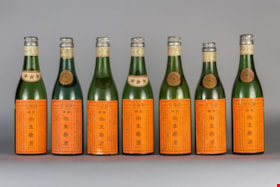

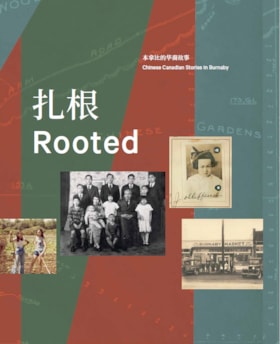
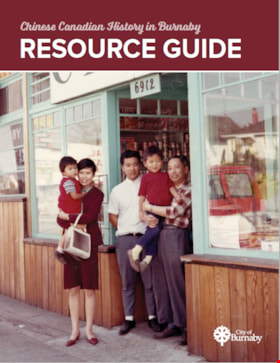
![Interview with Josephine Chow by Denise Fong February 7, 2020, [1900-2020] (interview content), interviewed Feb. 7, 2020 thumbnail](/media/hpo/_Data/_BVM_Images/2017/2017_0036_0004_001.jpg?width=280)
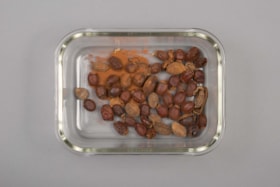
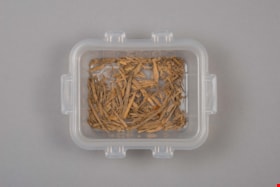
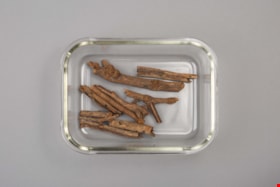
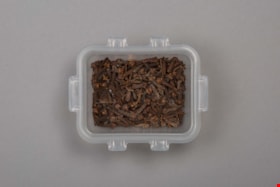

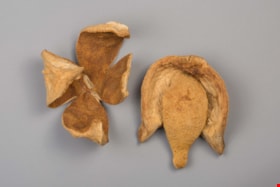
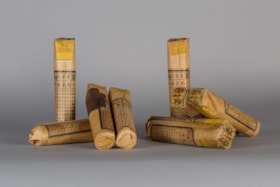
![Building plan, [c. 1900] thumbnail](/media/hpo/_Data/_BVM_Architectural_Drawings/1985_5331_0001_003%20.jpg?width=280)
